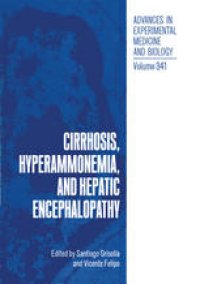
Ebook: Cirrhosis, Hyperammonemia, and Hepatic Encephalopathy
- Tags: Gastroenterology, Hepatology, Animal Anatomy / Morphology / Histology, Plant Sciences, Neurosciences
- Series: Advances in Experimental Medicine and Biology 341
- Year: 1993
- Publisher: Springer US
- Edition: 1
- Language: English
- pdf
This volume contains the papers presented in the International Summer Course on "Cirrhosis, Hyperammonemia and Hepatic Encephalopathy," which was one of the prestigious Summer Course, of the Complutense University of Madrid held in EI Escorial, Spain, during August 10-14, 1992. Liver cirrhosis is one of the main causes of death in western countries. In addition there is a series of liver dysfunctions including fulminant hepatic failure, Reye's syndrome and congenital defects of urea cycle enzymes that could lead to hepatic encephalopathy, coma and death. As a consequence of impaired liver function, the ability to detoxify ammonia by its incorporation into urea is diminshed, resulting in increased ammonia levels in blood and brain. Hyperammonemia is considered one of the main factors in the mediation of hepatic encephalopathy and the classical clinical treatments are directed towards reducing blood ammonia levels. A part of the book is therefore devoted to the study of certain aspects of ammonia metabolism such as the regulation of the urea cycle, the main mechanism of ammonia detoxification in mammals, which is located mainly in the liver. The metabolism of ammonia in other tissues, including brain, is also presented, as well as the effects of hyperammonemia on brain metabolism and function and on brain microtubules. The control of cerebral protein breakdown is reviewed. The classical and some recently proposed clinical treatments as well as nutritional considerations in the management of patients with liver failure are also discussed.
Content:
Front Matter....Pages i-viii
Control of Urea Synthesis and Ammonia Detoxification....Pages 1-12
Brain Metabolism in Hepatic Encephalopathy and Hyperammonemia....Pages 13-19
Ammonia Metabolism in Mammals: Interorgan Relationships....Pages 21-37
Clinical Manifestations and Therapy of Hepatic Encephalopathy....Pages 39-44
Nutritional Considerations in Patients with Hepatic Failure....Pages 45-56
Do Benzodiazepine Ligands Contribute to Hepatic Encephalopathy?....Pages 57-69
Effects of Hyperammonemia on Neuronal Function: NH4 +, IPSP and Cl--Extrusion....Pages 71-82
Activation of NMDA Receptor Mediates the Toxicity of Ammonia and the Effects of Ammonia on the Microtubule-Associated Protein MAP-2....Pages 83-93
Modulation of the Exocytotic Release of Neurotransmitter Glutamate by Protein Kinase C....Pages 95-105
Controls of Cerebral Protein Breakdown....Pages 107-117
Two Different Families of NMDA Receptors in Mammalian Brain: Physiological Function and Role in Neuronal Development and Degeneration....Pages 119-128
Ganglioside GM1 and its Semisynthetic Lysogangliosides Reduce Glutamate Neurotoxicity by a Novel Mechanism....Pages 129-141
Back Matter....Pages 143-148
Content:
Front Matter....Pages i-viii
Control of Urea Synthesis and Ammonia Detoxification....Pages 1-12
Brain Metabolism in Hepatic Encephalopathy and Hyperammonemia....Pages 13-19
Ammonia Metabolism in Mammals: Interorgan Relationships....Pages 21-37
Clinical Manifestations and Therapy of Hepatic Encephalopathy....Pages 39-44
Nutritional Considerations in Patients with Hepatic Failure....Pages 45-56
Do Benzodiazepine Ligands Contribute to Hepatic Encephalopathy?....Pages 57-69
Effects of Hyperammonemia on Neuronal Function: NH4 +, IPSP and Cl--Extrusion....Pages 71-82
Activation of NMDA Receptor Mediates the Toxicity of Ammonia and the Effects of Ammonia on the Microtubule-Associated Protein MAP-2....Pages 83-93
Modulation of the Exocytotic Release of Neurotransmitter Glutamate by Protein Kinase C....Pages 95-105
Controls of Cerebral Protein Breakdown....Pages 107-117
Two Different Families of NMDA Receptors in Mammalian Brain: Physiological Function and Role in Neuronal Development and Degeneration....Pages 119-128
Ganglioside GM1 and its Semisynthetic Lysogangliosides Reduce Glutamate Neurotoxicity by a Novel Mechanism....Pages 129-141
Back Matter....Pages 143-148
....